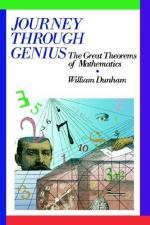|
This section contains 390 words (approx. 1 page at 400 words per page) |

|
The Non-Denumerability of the Continuum Summary and Analysis
While Euler and his work dominate the 18th century, Dunham writes, no single mathematician stands out in the century that follows. In the second half of the 19th century mathematics continues to exert its independence from the "real" world and centers more and more on the theoretical. Dunham sees a parallel in the world of art and the same time with the new styles of Cezanne, Gaugin and Van Gogh whose paintings are not literal representations of reality.
Dunham writes that while calculus has been in use for nearly two centuries, its foundations have not been completely examined in the late 19th century, especially its assumed notions about "infinitely large" and "infinitely small" quantities. In the intervening years these concepts have been the cause of ridicule from outside mathematics. Mathematicians turn to perfecting...
(read more from the The Non-Denumerability of the Continuum Summary)
|
This section contains 390 words (approx. 1 page at 400 words per page) |

|




